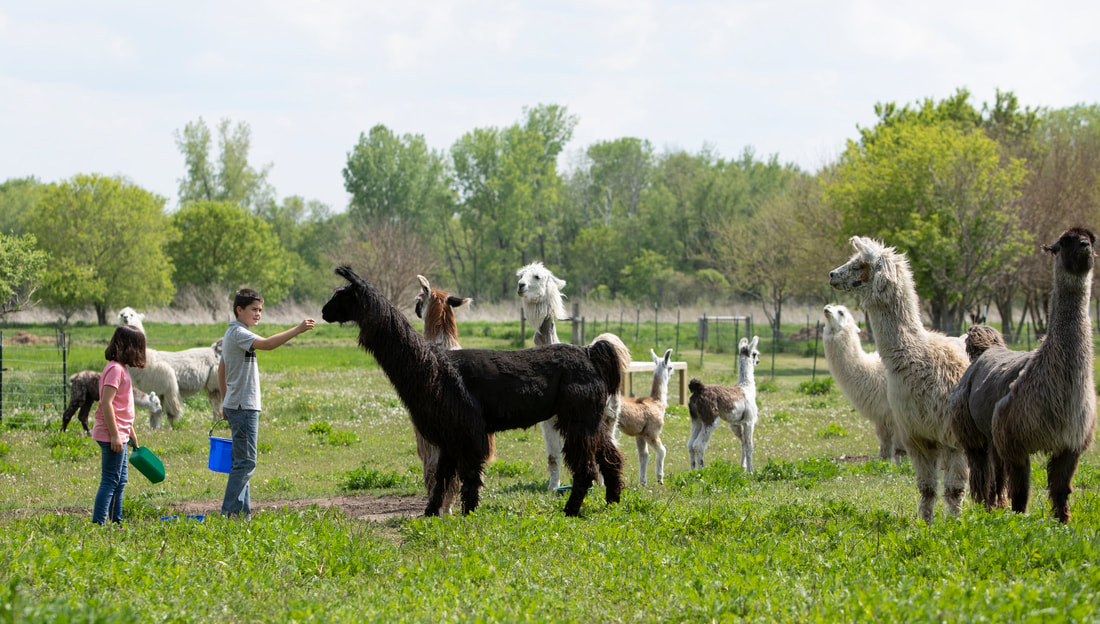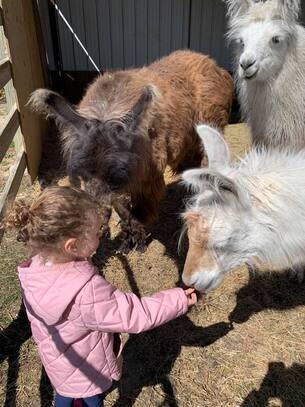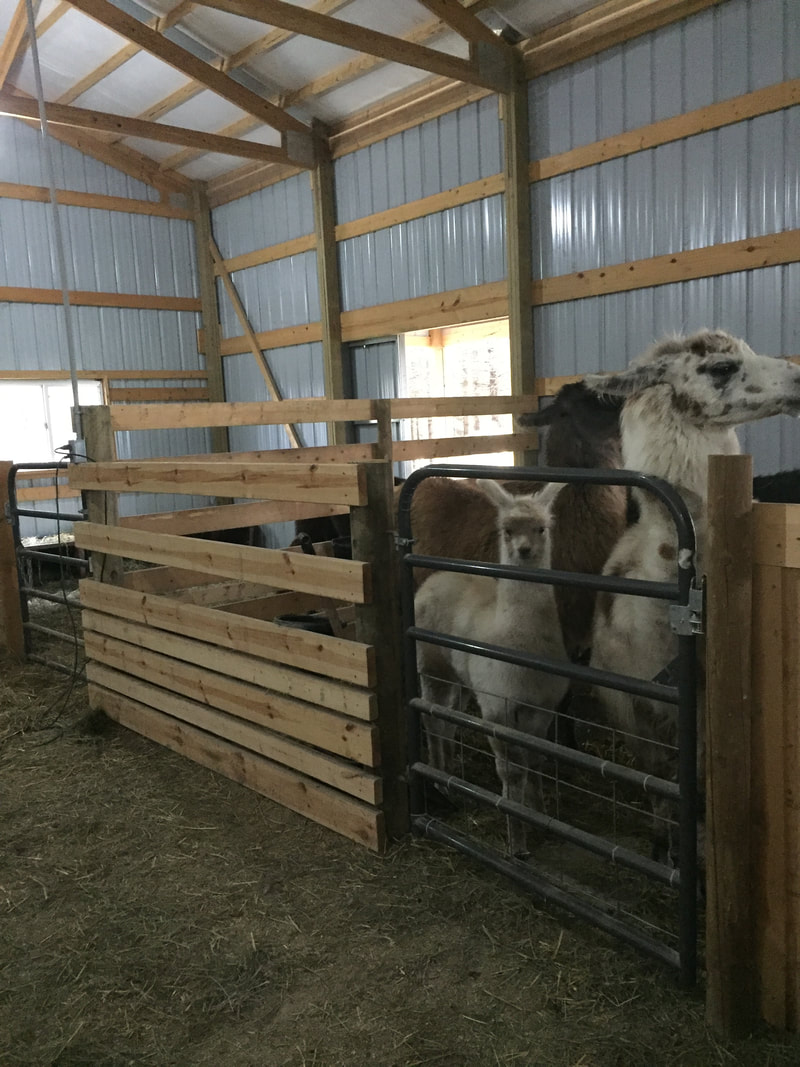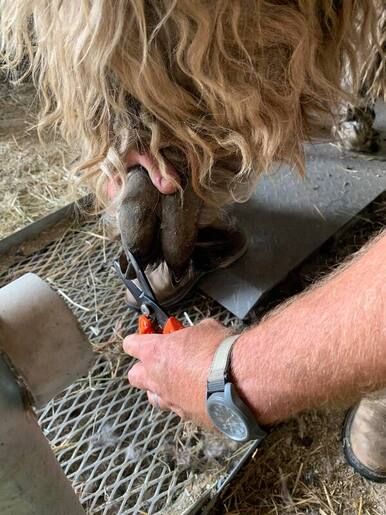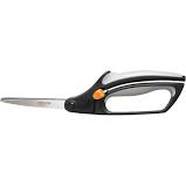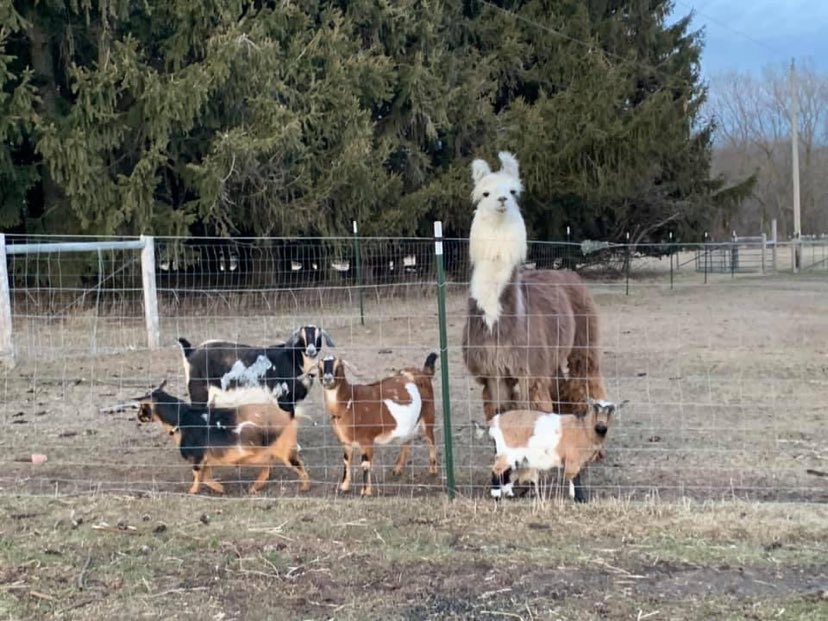LLAMAS, THE PERFECT ALTERNATIVE LIVESTOCK
The following information is what has worked well for our farm. Its also things we have learned in the past 30 years that we have raised llamas. There are certainly other ideas and practices that can work, these are just our experiences and what others have shared with us through the years. Please feel free to contact us with any questions.
Photo credit to Farm & Ranch Magazine
New To Llamas

Why would you want a llama?
If you have raised other livestock you will quickly see that llamas eat less, are easy on pastures, poop in one spot, are very intelligent, beautiful and graceful. If you want to raise a livestock that will keep your pastures trimmed, our easy to care for, don't make noise, do not destroy your grass fields and don't make tons of manure then you have found the perfect fit! Many of us our also looking for a livestock that we can get something from, but maybe feel that we don't want to eat them and they are far less expensive to take care of then a horse. They produce wool that can be harvested each spring and used to make yarn and other wool products. Their manure makes excellent compost for gardens and plants.
Llamas are gentle companions for all ages and easy to handle. Many enjoy taking them for walks. Because they are so gentle, llamas often are taken to hospitals, nursing homes, schools, parades, and public events. You can also teach them to pull a cart and use them for packing and livestock guards. A llamas average life span is 18-25 years.
What are llamas used for?
Some llamas are kept merely as pets, while others have a job as a guard or pack llama. Llamas can be shown in 4-H or open shows. They also can be taught to pull a cart.
The wool of a llama is very soft and lanolin-free. It is used for spinning, felting, crocheting, knitting, and weaving.
Can I own just one llama?
A llama should never be kept alone. Llamas have a strong herd instinct and do best with other llamas. Llamas can also be kept with goats, sheep, and alpacas as guards.
What do llamas eat?
A llama requires pasture in the summer and hay in the winter. Llamas do well on mainly good quality, grass with a little bit of alfalfa. One llama will eat about a bale of hay a week. Feeding high quality feed and minerals will yield a healthy llama.
Llamas are often fed grain for growing, nursing and breeding females. We also use grain as a way to get everyone up in the barn to halter them. We have a grain mixed at our feed mill but you can also buy commercially developed grain for llamas at your local feed store. How much grain to feed will depend on the animal. Llamas that are nursing, growing or older animals may require more. One of our llamas favorite treats are Purina Apple Horse treats. To feed 2 llamas it costs about $300-$400 per year depending on hay prices and pasture availability.
If you have raised other livestock you will quickly see that llamas eat less, are easy on pastures, poop in one spot, are very intelligent, beautiful and graceful. If you want to raise a livestock that will keep your pastures trimmed, our easy to care for, don't make noise, do not destroy your grass fields and don't make tons of manure then you have found the perfect fit! Many of us our also looking for a livestock that we can get something from, but maybe feel that we don't want to eat them and they are far less expensive to take care of then a horse. They produce wool that can be harvested each spring and used to make yarn and other wool products. Their manure makes excellent compost for gardens and plants.
Llamas are gentle companions for all ages and easy to handle. Many enjoy taking them for walks. Because they are so gentle, llamas often are taken to hospitals, nursing homes, schools, parades, and public events. You can also teach them to pull a cart and use them for packing and livestock guards. A llamas average life span is 18-25 years.
What are llamas used for?
Some llamas are kept merely as pets, while others have a job as a guard or pack llama. Llamas can be shown in 4-H or open shows. They also can be taught to pull a cart.
The wool of a llama is very soft and lanolin-free. It is used for spinning, felting, crocheting, knitting, and weaving.
Can I own just one llama?
A llama should never be kept alone. Llamas have a strong herd instinct and do best with other llamas. Llamas can also be kept with goats, sheep, and alpacas as guards.
What do llamas eat?
A llama requires pasture in the summer and hay in the winter. Llamas do well on mainly good quality, grass with a little bit of alfalfa. One llama will eat about a bale of hay a week. Feeding high quality feed and minerals will yield a healthy llama.
Llamas are often fed grain for growing, nursing and breeding females. We also use grain as a way to get everyone up in the barn to halter them. We have a grain mixed at our feed mill but you can also buy commercially developed grain for llamas at your local feed store. How much grain to feed will depend on the animal. Llamas that are nursing, growing or older animals may require more. One of our llamas favorite treats are Purina Apple Horse treats. To feed 2 llamas it costs about $300-$400 per year depending on hay prices and pasture availability.
Minerals (sheep or llama mineral) should be provided for your llamas’ free choice. Llamas also enjoy a salt block. Zinc and sea kelp can be added to the minerals to help with skin conditions and wool growth. Copper is toxic to llamas so don't feed goat minerals or goat feed to your llamas.
Fresh water should be available at all times. We use heated water buckets in the winter. Water buckets should be kept clean and clean water should be offered. If you wouldn't drink it don't expect them to.
Do llamas need a shelter?
The answer is yes. Llamas need to be able to get out of the rain and snow. It can be three sided. The roof should be high and provide for good circulation and air flow to keep the heat down in the summer. An old dairy barn, horse barn or pole shed works well. In the summer time if it gets above 85 degrees Fahrenheit I would also suggest a fan. Shade is ideal in the summer as well. We also recommend straw for bedding, straw is less likely to get stuck in their wool. We do not recommend wood shavings for this reason.
Fresh water should be available at all times. We use heated water buckets in the winter. Water buckets should be kept clean and clean water should be offered. If you wouldn't drink it don't expect them to.
Do llamas need a shelter?
The answer is yes. Llamas need to be able to get out of the rain and snow. It can be three sided. The roof should be high and provide for good circulation and air flow to keep the heat down in the summer. An old dairy barn, horse barn or pole shed works well. In the summer time if it gets above 85 degrees Fahrenheit I would also suggest a fan. Shade is ideal in the summer as well. We also recommend straw for bedding, straw is less likely to get stuck in their wool. We do not recommend wood shavings for this reason.
For our studs we have a 3 sided moveable shelter that we added a front. We face the opening South. In the winter we add the plastic strips to block the wind. This shelter is very economical for only a few animals.
What type of fencing does a llama require?
Llamas are pretty easy on fence compared to other livestock. It is recommended to be at least 4 feet tall or the llamas may jump out. There is a variety of fencing which can be used for your llamas such as wood, woven wire and high tensile fencing. DO NOT USE BARB WIRE. Also if you get a llama with good wool coverage electric fencing may not keep them in. They can’t feel the shock through their wool. We also recommend your pasture be free of burdock as they get burs stuck in their wool. Your pastures will stay nice because the soft pads on the bottom of their feet result in a low impact on the environment. They also typically use set areas for there potty spots so clean up is easier. We have used Bekaert Gaucho High Tensile Field Fence 14 ga, 47" x 330 ft from Tractor supply and Red Barron field fence and have found the Red Barron holds up a little better over time. Red Barron also offers tall fencing as well as various sizes with small wholes that work best to keep in goats and poultry if you are co-housing these species. We add a smooth wire to the top to increase the height for the male pens.
Llamas are pretty easy on fence compared to other livestock. It is recommended to be at least 4 feet tall or the llamas may jump out. There is a variety of fencing which can be used for your llamas such as wood, woven wire and high tensile fencing. DO NOT USE BARB WIRE. Also if you get a llama with good wool coverage electric fencing may not keep them in. They can’t feel the shock through their wool. We also recommend your pasture be free of burdock as they get burs stuck in their wool. Your pastures will stay nice because the soft pads on the bottom of their feet result in a low impact on the environment. They also typically use set areas for there potty spots so clean up is easier. We have used Bekaert Gaucho High Tensile Field Fence 14 ga, 47" x 330 ft from Tractor supply and Red Barron field fence and have found the Red Barron holds up a little better over time. Red Barron also offers tall fencing as well as various sizes with small wholes that work best to keep in goats and poultry if you are co-housing these species. We add a smooth wire to the top to increase the height for the male pens.
What type of care do they require?
Nail Trims
Llamas need their nails trimmed a few times per year. The bottom of their foot is padded like a dog, but they have 2 toenails on each foot that grow continuously. This is something you can do yourself. Ask your breeder to show you how. We use an orange handled livestock nail trimmer.
Llamas need their nails trimmed a few times per year. The bottom of their foot is padded like a dog, but they have 2 toenails on each foot that grow continuously. This is something you can do yourself. Ask your breeder to show you how. We use an orange handled livestock nail trimmer.
Shearing
Llamas need to be sheared annually. For us in Wisconsin that typically takes place the end of April or early May when temps at night stay above the mid 40's. Shearing is not only how we harvest their valuable fleece but also keeps the llamas cool in warm summers. They can develop heat stress if they are not sheared. You can do just a body clip or the entire body. I do recommend to shear the neck at least every other year to avoid mats. You can use a electric shears, we use a Premier 4000 clipper or my favorite if you only have a few llamas is the spring loaded Fiskars sewing scissors. (pictured below)
Llamas need to be sheared annually. For us in Wisconsin that typically takes place the end of April or early May when temps at night stay above the mid 40's. Shearing is not only how we harvest their valuable fleece but also keeps the llamas cool in warm summers. They can develop heat stress if they are not sheared. You can do just a body clip or the entire body. I do recommend to shear the neck at least every other year to avoid mats. You can use a electric shears, we use a Premier 4000 clipper or my favorite if you only have a few llamas is the spring loaded Fiskars sewing scissors. (pictured below)

Veterinary Care
Llamas need to be wormed for parasites. Frequency and type of dewormer depends on location. Doing a fecal float is highly recommended as to you can treat when needed and with the appropriate type of medication. We also give a subcutaneous injection of Ivomec every 4-6 weeks for the prevention of Meningeal worm. Do you research on this parasite as camelids are very susceptible and oral dewormers do not work. We also give them an annual CD&T vaccination. Contact your local veterinarian to set up a herd health program.
Gelding/Fighting teeth in male llamas
We recommend gelding your male between 12-18 months of age. Intact male llamas, 2-3 years of age may need to have their fighting teeth removed. This may need to be repeated every few years, each male is different. Occasionally females and geldings can get them, but its not common. Contact your veterinarian for more information.
Do llamas like to be handled?
Yes, most do. The more you interact positively with your llama the more they will want to be around you. You can take them for walks. Our llamas come up for treats. Just be patient and you will find llamas can a great companions. A llama will greet you by putting their nose on your nose. Often what we call a llama kiss!
How to halter a llama?
Use a llama halter made for llamas when haltering. You can purchase these at Farm N Fleet, Tractor Supply, Nasco and Useful Llama Company. A horse halter will not fit properly. When placing the halter the ring should sit high on the nose. It should not be too tight but not loose enough that it will slide down on the nose. When the halter it not fitted correctly the llama can have difficulty breathing. The halter should not be kept on the llama in a pasture. They can get hooked on fencing and hang themselves.
Yes, most do. The more you interact positively with your llama the more they will want to be around you. You can take them for walks. Our llamas come up for treats. Just be patient and you will find llamas can a great companions. A llama will greet you by putting their nose on your nose. Often what we call a llama kiss!
How to halter a llama?
Use a llama halter made for llamas when haltering. You can purchase these at Farm N Fleet, Tractor Supply, Nasco and Useful Llama Company. A horse halter will not fit properly. When placing the halter the ring should sit high on the nose. It should not be too tight but not loose enough that it will slide down on the nose. When the halter it not fitted correctly the llama can have difficulty breathing. The halter should not be kept on the llama in a pasture. They can get hooked on fencing and hang themselves.
Approach, Halter, and Lead Your Camelids With Ease
Here is a good video on how to halter and lead your llama or alpaca.
https://www.youtube.com/watch?v=L8suUEyYU14
https://www.youtube.com/watch?v=L8suUEyYU14
Winter Care in Cold Climates
Winter can be cold in the Midwest and we do find that we need to coat most of our suri fleeced llamas as well as old or very young llamas. Its important to also feed good quality hay and make sure they have shelter from the wind and snow. You should also use a heated water bucket so they have access to water at all times. You can purchase llama coats from Useful Llama Company or Amazon (Large Foal Coats for adults).
Winter can be cold in the Midwest and we do find that we need to coat most of our suri fleeced llamas as well as old or very young llamas. Its important to also feed good quality hay and make sure they have shelter from the wind and snow. You should also use a heated water bucket so they have access to water at all times. You can purchase llama coats from Useful Llama Company or Amazon (Large Foal Coats for adults).
Llamas in the Summer- Preventing Heat Stress
Watch your animals in this heat! It can be pretty warm here during the summer months on our farm and llamas are one of our animals that really can over heat and get heat stress if not cared for properly. Llamas should be sheared every spring before the heat comes.
1. Make sure they have some shade.
2. Provided Fans – Air circulation makes a big difference in how the area is cooled down.
3. Give fresh cold water daily. Also make sure your water buckets are clean.
4. Provide kiddie pools for them to get into.
5. Spray down the ground where they lay. Or some llamas even like misters or to be sprayed on the legs and belly with the hose.
6. If you feed grain feed when the temperatures are cooler. Digestion creates extra heat.
1. Make sure they have some shade.
2. Provided Fans – Air circulation makes a big difference in how the area is cooled down.
3. Give fresh cold water daily. Also make sure your water buckets are clean.
4. Provide kiddie pools for them to get into.
5. Spray down the ground where they lay. Or some llamas even like misters or to be sprayed on the legs and belly with the hose.
6. If you feed grain feed when the temperatures are cooler. Digestion creates extra heat.
Additional Resources
International Llama Registry (ILR)
The ILR is where you can register your lamas as well as many resources about llamas. https://secure.lamaregistry.com/
Llamas used for Guarding Livestock
Guard llamas can be very beneficial to protect your livestock from small predators like fox and coyotes. Our llamas grow up with our goats and are so gentle around them. Our Nigerian kids are only a few pounds and run around the llamas feet. Not all llamas are fit to be a guard llama so do your research before selecting one.
Dispelling the Myths about Guard Llamas written by Carol Reigh click here
Midwest Llama Packing
Learn more about llama packing or plan your hike using pack llamas.
https://www.midwestllamapacking.com/
https://www.midwestllamapacking.com/
Proudly powered by Weebly
